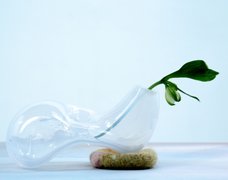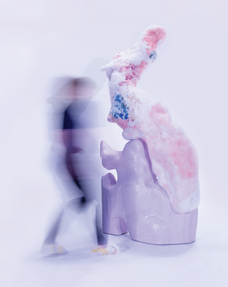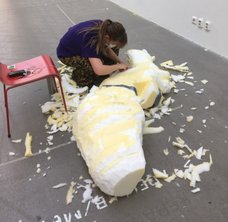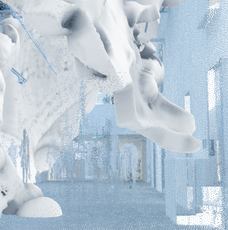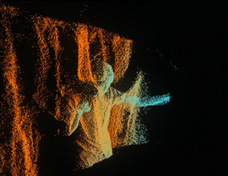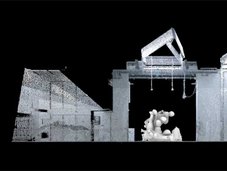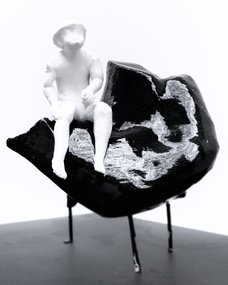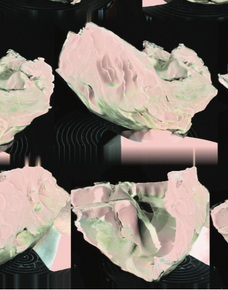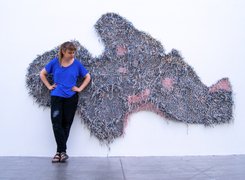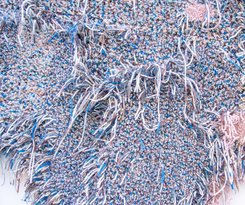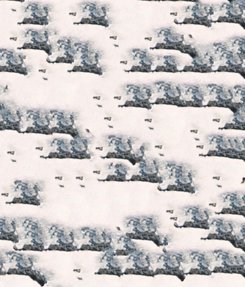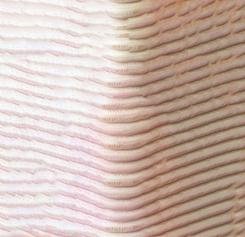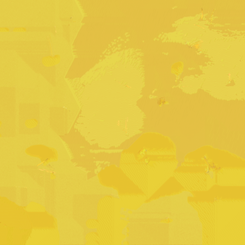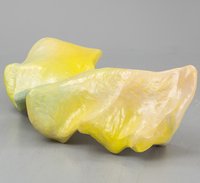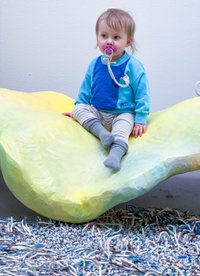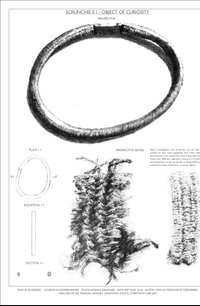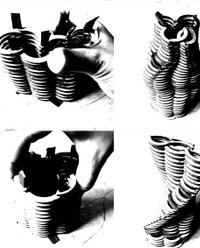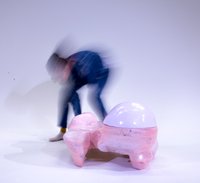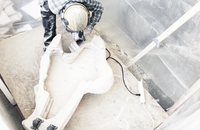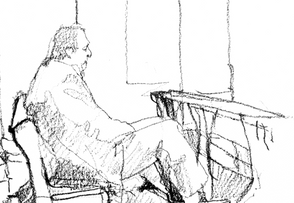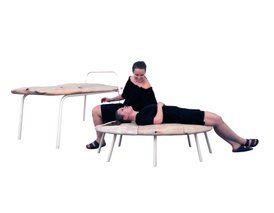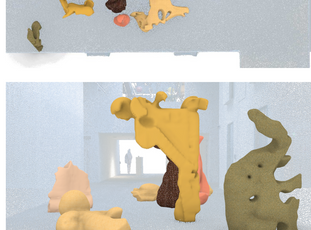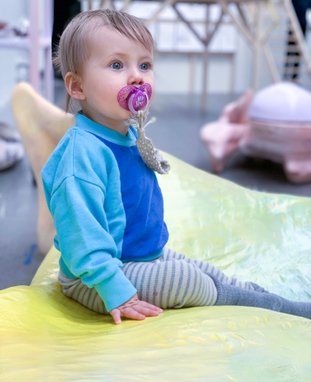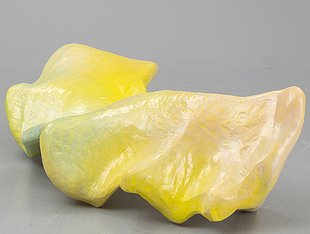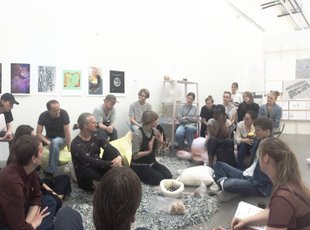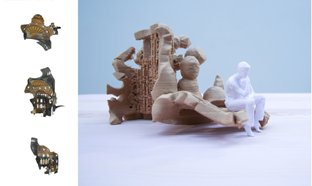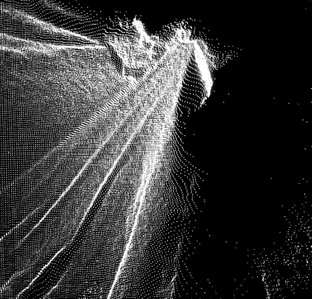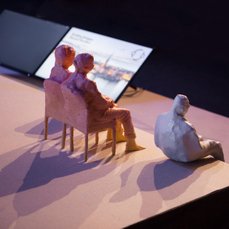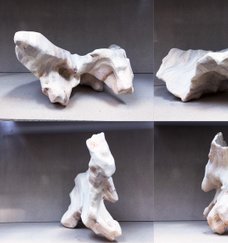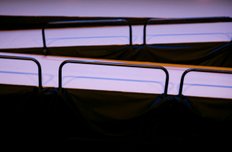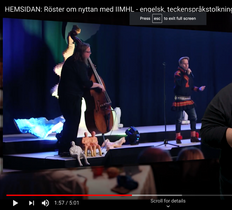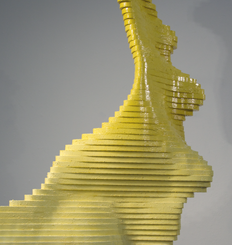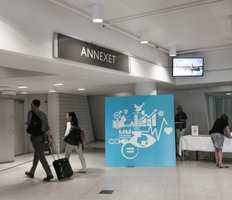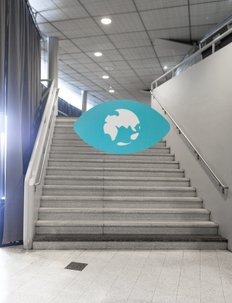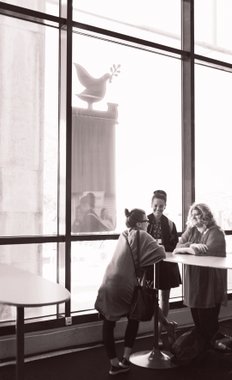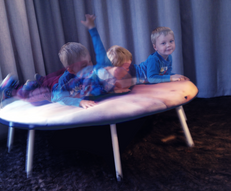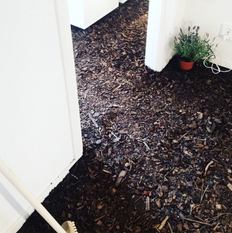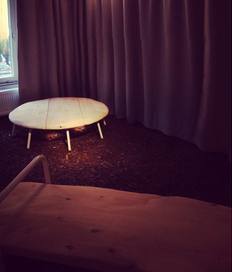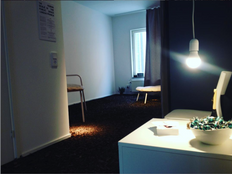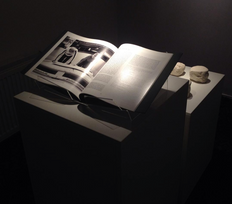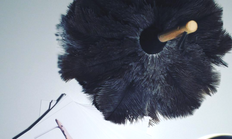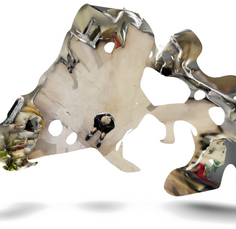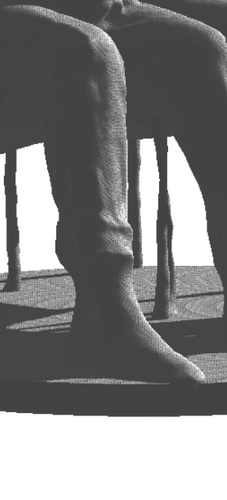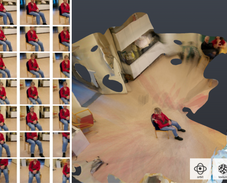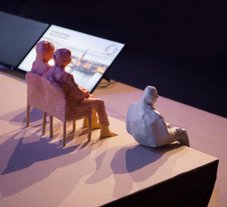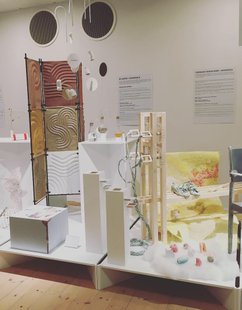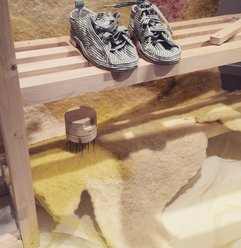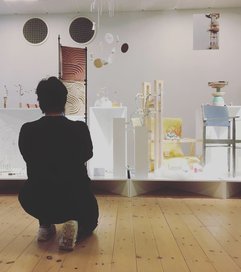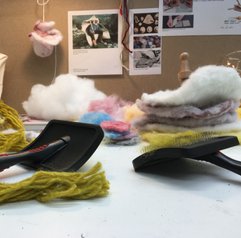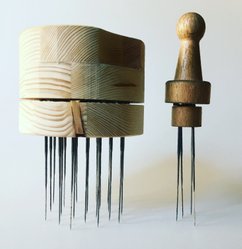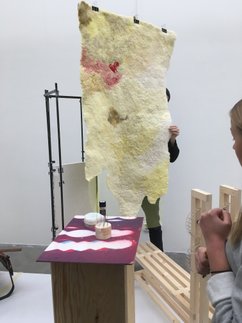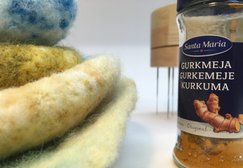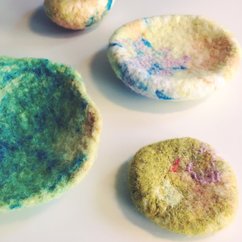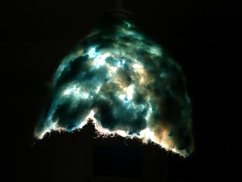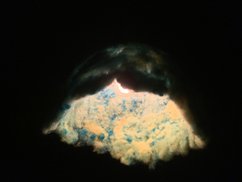Arkitektur Memorabilia
Memorabilia are objects that we save or collect because they remind us of people or events. When my grandmother passed away, my grandfather suffered a stroke and developed dementia. He was bothered by how the surroundings suddenly felt foreign. Through grandfather's music and personal items, we were able to find each other. I draw inspiration from memorabilia that can be found in many people's homes and my wish is to make more people experience the world as a little more familiar.
For the exhibition, I am showing a series of sculptural outdoor furniture organized around stage activity. The stage was created in collaboration with Barnens Å-hus and a group of children who filled it with good food and drink for everyone to enjoy.
BIG DATA PATTERN DESIGN
BIG DATA PATTERN DESIGN is a computer and human craft collaboration. The digital wear and tear expressed in the imagery create through its deviation something fragile, fragmented, messy and familiar, human and precious.
The patterns designed by Cecilia Margareta Tjärnberg have been created during 2018-2020 and is a part of an ongoing study.
Point cloud illustrations
In the chapter of "Point Cloud Illustrations" the aim is to develop creative processes handling this data while exploring and developing upon ideas of spatial projection.
Point Cloud Illustrations are made from data captured through 3D scanning. Many examples presented here are taken from my MFA thesis project which is based on data captured through different types of 3D scanning utilizing a range of different technologies.
Glass exhibited on a shelf designed by Cecilia Margareta Tjärnberg, glass blowing by Rasmus Nossbring during a collaborative creative design process, 2019
Needle feltings by Cecilia, 2018
Glass
The collaborative design experiment and resulting small series of hand-blown glass pouches belongs to the MFA thesis BIG DATA DESIGN - Strange but familiar. The glass was blown by Crafts/Glass Artist Rassmus Nossbring directly on one of the wood carvings created by Cecilia. During the workshop, different techniques and strategies were explored. The series of sculptural glass pouches vary in transparent, semitransparent and with a blend of opal white.
One important idea for this workshop was to allow for both artist's craftsmanship and ideas to be voiced. Thereby utilizing the creativity and knowledge available.
Collaborative creative process, Gustavsbergs porslinsfabrik, 2019
Supervisors; Einar Rodhe, Senior Lecturer, Konstfack University of Arts, Crafts and Design, Department of Design, Interior Architecture and Visual Communication (DIV).
Christian Björk, Visiting Lecturer, -
Examiners; Tor Lindstrand, Senior Lecturer, Konstfack University of Arts, Crafts and Design, Department of Design, Interior Architecture and Visual Communication (DIV).
Guest critic; Marcia Harvey Isaksson, Inredningsarkitekt MSA
Sponsors; Sundsvalls Kommun - Cultural Grant, SCA Östrands massafabrik - paper material, Kasthall - yarn
Selected tutors and collaborating partners; Palle Torsson, Senior Lecturer, Department of Fine Art. Gunnar Söder, Lecturer within the Department of Design at Konstfack. Alexander Wallin, a computer programmer, and musician. Rasmus Nossbring, Glass/Craft Artist.
Photo by Sawsan Ahmed, 2019.
Elephant
The sculptural wall element is a part of a series of furniture belonging to the MFA thesis BIG DATA DESIGN - Strange but familiar. The form is originally based on a photogrammetry project made up of images taken of interiors at Hagia Sophia in Istanbul. I pulled many forms from this initial digital work. I call them my inside out interiors. The Bench and Carpet 0.1 were also derived from here. The Elephant was developed as a high rising complement to the small series of furniture built for the degree show.
The base is heavy and constructed in pine and plywood. The top is fixed in place with two steel pins. The sculptural foam swirl on top brings the whole piece to life. I can imagen these types of wall-like structures moved around in an open office landscape. My Elephant disturbs notions of direction in a fun and inviting manner. The textile element absorbs sound while also softening up the straight lines of modern architecture as it seems to pull all the attention in the room.
The design was built, power carved, painted and needle felted by Cecilia Margareta Tjärnberg. Sponsor: Sundsvalls Kommun.
During my work, I push many angles in the project simultaneously. It is important to bring these different parts together regularly, to allow for continuous renegotiation.
Milling inside my plasic tent.
I created the foam sculpture by up-cycling a standard foam mattress.
Supervisors; Einar Rodhe, Senior Lecturer, Konstfack University of Arts, Crafts and Design, Department of Design, Interior Architecture and Visual Communication (DIV).
Christian Björk, Visiting Lecturer, -
Examiners; Tor Lindstrand, Senior Lecturer, Konstfack University of Arts, Crafts and Design, Department of Design, Interior Architecture and Visual Communication (DIV).
Guest critic; Marcia Harvey Isaksson, Inredningsarkitekt MSA
Sponsors; Sundsvalls Kommun - Cultural Grant, SCA Östrands massafabrik - paper material, Kasthall - yarn
Selected tutors and collaborating partners; Palle Torsson, Senior Lecturer, Department of Fine Art. Gunnar Söder, Lecturer within the Department of Design at Konstfack. Alexander Wallin, a computer programmer, and musician. Rassmus Nossbring, Glass/Craft Artist.
Section, photogrammetry poly-mesh paird with point cloud, Konstfack 2019
Point cloud illustrations
In the chapter of "Point Cloud Illustrations" the aim is to develop creative processes handling this data while exploring and developing upon ideas of spatial projection.
Point Cloud Illustrations are made from data captured through 3D scanning. Many examples presented here are taken from my MFA thesis project which is based on data captured through different types of 3D scanning utilizing a range of different technologies.
Laser scanning of students interacting in workshop at Konstfack University of Arts, Crafts and Design, 2019
Scen from Alexander Wallins music video Carneval, point cloud in motion, 2019
Kinect+Processing
During this collaborative project "low tech scanning" as a creative outlet was explored utilizing a discontinued device from the gaming industry. The workshop was done together with Alexander Wallin, a computer programmer, and musician, and with support from Palle Torsson visual artist and Senior Lecturer at Konstfack and Gunnar Söder artist and Lecturer at Konstfack.
The motion point cloud data was created through 3d scanning using a Kinect motion sensor paired with a computer and the open-source software Processing. This project was a part of the MFA thesis BIG DATA DESIGN.
Music by Alexander Wallin, computer programmer, and musician.
Filming with Alexander we took advantage of our direct surroundings and built a temporary interactive stage using bubblewrap and mirrors. The effects were amazing. Another new alternative material that is being developed is augmented reality. Through further collaboration with computer programmers, the field of architecture can utilize the technology to create an interactive digital spatial design. We already create digital material and to explore different ways to interact with this material is a natural next step. Through augmented reality, we can see and interact with three-dimensional digital architecture outside the computer. You just need a smartphone. Working with the Kinect, I have experimented with projecting recorded live-streaming three-dimensional point-cloud motion. This digital interactive architecture does not require the user to interact with a smartphone and it can be never-endlessly scaled up, limited only by the power of the projector or the size of the available screen. When working with 3D data in the computer, you can change the perspective of the design at any time. This is practical. The same can be done with a mirrored point cloud recording while a person is dancing in front of a Kinect sensor. The experience of seeing yourself on the wall from a side perspective when you know you are facing the camera directly is reminiscent of entering a funhouse mirror section. It's confusing and because your brain wants to catch up with what's happening, you will start raising an arm, move a little to the left and then move back. I am used to working in 16 15 three-dimensional digital space, but the physical experience of this interaction is challenging. It is different when the whole body becomes part of the interaction.
Process from collaborative workshop, Kinect and Processing, Cecilia Margareta Tjärnberg and Alexander Wallin 2019
Design process sketching, section, photogrammetry poly-mesh paird with point cloud, Konstfack 2019
The Fountain of Sven Bertil Taube, Hyperdrawing, part two, by Cecilia Margareta Tjärnberg 2018
Spolia
(Text 3. Final words, by Cecilia)
This work concerns curiosity found in translation. Through capturing reality seen through a camera lens, the images assembled have generated my space. Space which immediately shrunk compared to the original donor structure. My world became this new dimension, my very own up-side-down. It gradually becomes more abstracted. In one area I can identify the materials used, then to find my self in a surrealistic wonderland. A bit dark perhaps.
The presented project is the result of an individual investigation that took place after a group exercise of documenting a donor structure found in heterotopia which is Gröna Lund. My main interest is found in the translations of information through different media. The theme embraced throughout the course is the idea of working with spolia. Location: Konstfack, or University College of Arts. Teacher: Einar Rodhe, Senior Lecturer, Konstfack University of Arts, Crafts and Design, Department of Design, Interior Architecture and Visual Communication (DIV) and James Hamilton, guest teatcher - . Guest critic: Konstantinos Pantazis from Point Supreme
The sculpture of Sven-Bertil Taube digitally unfolded and 3d printed. Sven-Bertil is now no longer locked in his initial posed position is resting comfortably on a sculptural super-sofa. The design behind the sofa is based on data pulled from Sven-Bertil's own form. In this surrealistic alternative world, he is stretching out in his own hand.
Light structure scanning, clay cast
The Fountain, Hyperdrawing, part one, by Cecilia Margareta Tjärnberg and Revaz Berdzenishvili. Together we messured the area of the fountain and collected 3d data through both photogramerty and hands on clay reliefes. In the first hyperdrawing this data is compiled.
(TEXT 1. Analysis of the donor structure, by Revas and Cecilia)
Laconic creation constantly keeps the movement of the water and houses organic life. Fleeting mirrors create portals to “the other space” to a heterotopia. Slivers of the surrounding architecture shimmers at us as we move around the fountain. The Mexican food court, the pastel colored façade of the American 50 ́s hotdog stand, roller-coasters in the distance. Though in contrast to its material context the logic of the fountain is ephemeral and it is depressed.
The Human Scale In The Public Space - Lingua Franca
My BFA project treating the subject of how we can design furniture for the public space through materializing the human scale, which is “in size close to mine and in spirit personal”.
We are entering a new era of urban development, where access to personalized technological aids which are allowing us to be more personal in the public space is also having a detrimental effect on our social routine - I am inspired to materialize a metaphorical bridge, a hypothetical lingua franca.
In an effort to materialize the human scale I have researched language and understanding, music and memory. My method of progress is bound to my interest in handicraft and digital fabrication. I reached out to a home for the elderly located in Uppsala and organized a workshop. My plan was to develop the thesis based on the material I could collect here.
During the workshop, we worked with clay while listening to music. In advance, I had asked the staff what music the elderly would like to hear. Music has the power to awaken memory and “Music creates spontaneity that you can not create in an institution, it takes you to a place where you can leave the regimen and go of in a world that you create and that you connect with on your own terms” (Alive Inside, 2014). Something very fragile and very personal was created during the workshop.
I brought back the small sculptural objects to Konstfack, had them 3D scanned and processed digitally. My final design, the two benches, was CNC milled at Scania AB.
Location: Konstfack, or University College of Arts, Crafts and Design/ Pärlan, Hamgånge. Teachers: Sergio Montero Bravo, Pernilla Glaser. In collaboration with residents at Attendo Topelius in Uppsala, Scania AB in Södertälje and Hemgården AB.
(Read the whole essay below)
BIG DATA DESIGN - Strange but familiar
MFA thesis, 2019
An exploration of the future of spatial design expression, consistent with new technologies available and contemporary digital design processes. In the digital realm, the information captured presents itself as a messy abstraction to the original where some information is added while other is lost.
In order to push my tools and knowhow, I initiated interdisciplinary dialogues with a series of different professionals.
Download the thesis here.
Supervisors; Einar Rodhe, Senior Lecturer, Konstfack University of Arts, Crafts and Design, Department of Design, Interior Architecture and Visual Communication (DIV).
Christian Björk, Visiting Lecturer, -
Examiners; Tor Lindstrand, Senior Lecturer, Konstfack University of Arts, Crafts and Design, Department of Design, Interior Architecture and Visual Communication (DIV).
Guest critic; Marcia Harvey Isaksson, Inredningsarkitekt MSA
Sponsors; Sundsvalls Kommun - Cultural Grant, SCA Östrands massafabrik - paper material, Kasthall - yarn
Selected tutors and collaborating partners; Palle Torsson, Senior Lecturer, Department of Fine Art. Gunnar Söder, Lecturer within the Department of Design at Konstfack. Alexander Wallin, a computer programmer, and musician. Rassmus Nossbring, Glass/Craft Artist.
The Ultimate Empathy Machine
Curating information through conversation while using music as a tool to awaken memory, photogrammetry and digital manufacturing. We drew on the table cloth and shared a homemade carrot cake. This is a sample of an individual investigation taking place after weeks of class discussions and workshops. Teachers: Sergio Montero Bravo, Pernilla Glaser. In collaboration with FoajeX and Pärlan.
During a workshop Birgitta was asked where she saw herself in the future. Upon which she turned to me and asked, “I am seventy years old, what future?”
I got scared. I didn’t know how to answer her. Though she also caught my interest. I started to wonder, why is that question so hard for her to answer? Why is some questions difficult to answer for some people but not for others? In this project the goal have been to stay in the process and to develop strategies and test tools with which to communicate with a third party. I decided to stay with a group of seniors at a meeting place called Pärlan in Hamrånge. During the two meetings we ended up talking a lot about loneliness, in the presence and the future. Happiness regarded memories of an earlier life and Margareta told a story about the normal occurrence of the whole family going to the outhouse together. There is so much love here but very little hope for a future.
As I was bidding farewell for the second time at Pärlan one of the caregivers said, “your generation will probably have other demands and then things will be different”.
Carpet 0.1 mounted on the wall like a tapestry, wool- and linen thread from Kasthall, design by Cecilia Margareta Tjärnberg, MFA BIG DATA DESIGN - Strange but familiar, 2019
Carpet 0.1
The carpet design project is a part of the MFA thesis BIG DATA DESIGN - Strange but familiar. The textile element was developed to complement and frame the heavy sculptural wood furniture.
The carpet is envisioned as an early-season crisp spring field of wild-grown grass. The thread length is varied to sections of 20mm and 30mm. The design is consciously exhibited un-cut. The wild spouting seemingly random spread of these un-cut threads is embraced as an important part of the final design.
Carpet 0.1 was tufted at Konstfack by Cecilia Margareta Tjärnberg. Material sponsored by Kasthall.
Carpet 0.1, detail
Supervisors; Einar Rodhe, Senior Lecturer, Konstfack University of Arts, Crafts and Design, Department of Design, Interior Architecture and Visual Communication (DIV).
Christian Björk, Visiting Lecturer, -
Examiners; Tor Lindstrand, Senior Lecturer, Konstfack University of Arts, Crafts and Design, Department of Design, Interior Architecture and Visual Communication (DIV).
Guest critic; Marcia Harvey Isaksson, Inredningsarkitekt MSA
Sponsors; Sundsvalls Kommun - Cultural Grant, SCA Östrands massafabrik - paper material, Kasthall - yarn
Selected tutors and collaborating partners; Palle Torsson, Senior Lecturer, Department of Fine Art. Gunnar Söder, Lecturer within the Department of Design at Konstfack. Alexander Wallin, a computer programmer, and musician. Rassmus Nossbring, Glass/Craft Artist.
Simrishamn - BIG DATA PATTERN DESIGN, 2018
BIG DATA PATTERN DESIGN
BIG DATA PATTERN DESIGN is a computer and human craft collaboration. The digital wear and tear expressed in the imagery create through its deviation something fragile, fragmented, messy and familiar, human and precious.
The patterns designed by Cecilia Margareta Tjärnberg have been created during 2018-2020 and is a part of an ongoing study.
BIG DATA PATTERN DESIGN, 2020
BIG DATA PATTERN DESIGN, 2020
Gul - BIG DATA PATTERN DESIGN, 2018
The Oyster Sofa
The sofa is a part of a series of furniture belonging to the MFA thesis BIG DATA DESIGN - Strange but familiar. The form of the sofa is originally based on a light structure scanned oyster shell picked up on a beach in Thailand. The seating touches the ground and tilts up reaching 50 cm in height. Combined with the high gloss lacquer finish this feature enables kids to climb up and to slide down the design. My favorite place is down to the right, where I once almost fell asleep sitting on the floor leaning into the sofa which seamed to be caressing me. The color spectrum is wild in its character like youth and I find it communicates a notion of something ephemeral.
Material: MDF, plywood, massive wood. Finish: Color, high gloss lacquer. The main profiles were milled by Södermalms Skyltfabrik in Stockholm. The design was built, carved and painted at Konstfack by Cecilia Margareta Tjärnberg. Sponsors: Södermalms Skyltfabrik and Fredricsons Trä.
The Oyster Sofa and Carpet 0.1, visitors at the degree show, Konstfack 2019
Supervisors; Einar Rodhe, Senior Lecturer, Konstfack University of Arts, Crafts and Design, Department of Design, Interior Architecture and Visual Communication (DIV).
Christian Björk, Visiting Lecturer, -
Examiners; Tor Lindstrand, Senior Lecturer, Konstfack University of Arts, Crafts and Design, Department of Design, Interior Architecture and Visual Communication (DIV).
Guest critic; Marcia Harvey Isaksson, Inredningsarkitekt MSA
Sponsors; Sundsvalls Kommun - Cultural Grant, SCA Östrands massafabrik - paper material, Kasthall - yarn
Selected tutors and collaborating partners; Palle Torsson, Senior Lecturer, Department of Fine Art. Gunnar Söder, Lecturer within the Department of Design at Konstfack. Alexander Wallin, a computer programmer, and musician. Rasmus Nossbring, Glass/Craft Artist.
Scrunchie
Developing a cabinet of curiosity through process of investigations of an chosen object. While examining my chosen object I state that the scrunchie can be said to consist of two main segments, one inner elastic band and an outer protective interacting shell. How these two different segments interact, in function and aesthetics, as the scrunchie is being pulled and released is what makes this a curious object. I do my research through producing model construction. Partly because I wanted to use the laser cutter as much as possible, but also in order to start gathering knowledge of material characteristics in an early stage. This short course was summarised with us building our cabinets in scale 1:1 and then in groups starting the discussion on possible relationships, one cabinet to another/ cabinet to user.
The assignment was to choose an object of curiosity and then figure out it’s essens; what makes the thing curious? After isolating this quality a set of modells were produced embrasing it and finaly a cabinett of cutiosity designed on it’s principal. Location: Aarhus School of Architecture. Teacher: Peter Mandal Hansen, Jonathan Foote, Christian Carlsen. Date: September 2016
Sketch models
Frederik casually testing out my Cabinet of curiosity during a group meeting, Aarhus School of Architecture
Bench, photogrammetry and woodcarving, design by Cecilia Margareta Tjärnberg, MFA thesis BIG DATA DESIGN - Strange but familiar, 2019
Bench
The low seating element is a part of a series of furniture belonging to the MFA thesis BIG DATA DESIGN - Strange but familiar. The form is originally based on a photogrammetry project made up of images taken of interiors at Hagia Sophia in Istanbul. I pulled many forms from this initial digital work. I call them my inside out interiors. The Elephant and Carpet 0.1 were also derived from here. The bench was developed as a low sturdy element to compliment the small series of furniture built for the degree show.
The low seated design urges small children to play. The tilting levels and uneven surface presents great tools for gripping on to and climbing up on. Two heights of seating are included. The translucent coloring fades between lavendel, raspberry, and peach.
The design was built, power carved and painted by Cecilia Margareta Tjärnberg. Sponsors: Sundsvalls Kommun.
Supervisors; Einar Rodhe, Senior Lecturer, Konstfack University of Arts, Crafts and Design, Department of Design, Interior Architecture and Visual Communication (DIV).
Christian Björk, Visiting Lecturer, -
Examiners; Tor Lindstrand, Senior Lecturer, Konstfack University of Arts, Crafts and Design, Department of Design, Interior Architecture and Visual Communication (DIV).
Guest critic; Marcia Harvey Isaksson, Inredningsarkitekt MSA
Sponsors; Sundsvalls Kommun - Cultural Grant, SCA Östrands massafabrik - paper material, Kasthall - yarn
Selected tutors and collaborating partners; Palle Torsson, Senior Lecturer, Department of Fine Art. Gunnar Söder, Lecturer within the Department of Design at Konstfack. Alexander Wallin, a computer programmer, and musician. Rassmus Nossbring, Glass/Craft Artist.
My project Arkitektur Memorabilia is currently being exhibited at Ung Salong "Sprickan" hosted by Uppsala Konstnärsklubb, August 8 - 30th.
Arkitektur Memorabilia
Memorabilia are objects that we save or collect because they remind us of people or events. When my grandmother passed away, my grandfather suffered a stroke and developed dementia. He was bothered by how the surroundings suddenly felt foreign. Through grandfather's music and personal items, we were able to find each other. I draw inspiration from memorabilia that can be found in many people's homes and my wish is to make more people experience the world as a little more familiar.
For the exhibition, I am showing a series of sculptural outdoor furniture organized around stage activity. The stage was created in collaboration with Barnens Å-hus and a group of children who filled it with good food and drink for everyone to enjoy.
Sprickan, organised by Uppsala Konstnärsklubb 2020. Point cloud-film by Cecilia Margaret Tjärnberg.
Life Drawing
Before I ever started thinking about design, I drew. Over the years I have developed my technique, many thanks to good teachers. These drawings are some of my life drawings. The pictures describe people living their lives, often unaware that I am drawing them. I draw landscapes and things in motion. I try to push and pull and let the line search... The drawing is never finished, and I believe that this gives life.
The Bench and the Platform. One higher bench is easier to stand up from when you have bad knees and one lower platform allows children to climb up themselves.
The Human Scale In The Public Space - Lingua Franca
My BFA project treating the subject of how we can design furniture for the public space through materializing the human scale, which is “in size close to mine and in spirit personal”.
We are entering a new era of urban development, where access to personalized technological aids which are allowing us to be more personal in the public space is also having a detrimental effect on our social routine - I am inspired to materialize a metaphorical bridge, a hypothetical lingua franca.
In an effort to materialize the human scale I have researched language and understanding, music and memory. My method of progress is bound to my interest in handicraft and digital fabrication. I reached out to a home for the elderly located in Uppsala and organized a workshop. My plan was to develop the thesis based on the material I could collect here.
During the workshop, we worked with clay while listening to music. In advance, I had asked the staff what music the elderly would like to hear. Music has the power to awaken memory and “Music creates spontaneity that you can not create in an institution, it takes you to a place where you can leave the regimen and go of in a world that you create and that you connect with on your own terms” (Alive Inside, 2014). Something very fragile and very personal was created during the workshop.
I brought back the small sculptural objects to Konstfack, had them 3D scanned and processed digitally. My final design, the two benches, was CNC milled at Scania AB.
Location: Konstfack, or University College of Arts, Crafts and Design/ Pärlan, Hamgånge. Teachers: Sergio Montero Bravo, Pernilla Glaser. In collaboration with residents at Attendo Topelius in Uppsala, Scania AB in Södertälje and Hemgården AB.
(Read the whole essay below)
Poly-mesh form and point cloud space, process material
BIG DATA DESIGN - Strange but familiar
MFA thesis, 2019
An exploration of the future of spatial design expression, consistent with new technologies available and contemporary digital design processes. In the digital realm, the information captured presents itself as a messy abstraction to the original where some information is added while other is lost.
In order to push my tools and knowhow, I initiated interdisciplinary dialogues with a series of different professionals.
Download the thesis here.
Supervisors; Einar Rodhe, Senior Lecturer, Konstfack University of Arts, Crafts and Design, Department of Design, Interior Architecture and Visual Communication (DIV).
Christian Björk, Visiting Lecturer, -
Examiners; Tor Lindstrand, Senior Lecturer, Konstfack University of Arts, Crafts and Design, Department of Design, Interior Architecture and Visual Communication (DIV).
Guest critic; Marcia Harvey Isaksson, Inredningsarkitekt MSA
Sponsors; Sundsvalls Kommun - Cultural Grant, SCA Östrands massafabrik - paper material, Kasthall - yarn
Selected tutors and collaborating partners; Palle Torsson, Senior Lecturer, Department of Fine Art. Gunnar Söder, Lecturer within the Department of Design at Konstfack. Alexander Wallin, a computer programmer, and musician. Rassmus Nossbring, Glass/Craft Artist.
Consciously utilizing BIG DATA as a part of the creative design process and automating certain design tasks is an important part of the evolution of contemporary digital design processes. These new digital tools invite us into a complex world of infinite and instant possibilities. The tools we use feed back into the things that we make. However, the traces made by the data-driven wear and tear leave us with surprisingly manifold qualities. The traces from the digital and the physical wear and tear left by these new technologies communicate important humanistic values which more often are distinguished in the crafts. This second digital turn in architecture makes way for a new design language - Strange but familiar.
Elephant, photogrammetry and powercarving/woodcarving, 2019
Visitors in the exhibition during the degree show, BIG DATA DESIGN - Strange but familiar, photo by Pauline Johansson, 2019
In the back you can see the bench I call Bench.
BIG DATA DESIGN strange but familiar is a thesis project where new technologies are used to explore the future of spatial design expression by exploring the possibilities of contemporary digital design processes. The focus is fixed on embracing the digital and physical wear and tear throughout the project. As the project comes to a full circle and a proposal in scale 1:1 has been built, questions about new materials, open source design, and not the least the relevance of architects are raised. In this landscape of physical spatial elements, you are invited to explore thresholds between the real and the virtual.
In naming the project from the perspective of a spatial designer I am referring to new methods of design relevant to the field and the term “big data” in general intending “The new tools helping us find relevant data and analyze its implications”. I collect data through different types of 3d scans exploring a range of technologies, from precise laser scanning to hacking a discontinued motion-sensing input device derived from the gaming industry. I am interested in how the form translates as it moves between the physical and the digital realm. In the digital realm, the information captured presents itself as a messy abstraction of the original where some data is added while other data is lost. Developing the material, I adopt complex content-aware auto-fill algorithms, a strategy that is essential for the project. This strategy is applied both in the digital and physical form. I have, during my work, been educating myself about how different alternative digital tools work and how these react to different kinds of information. I am using my insights to control certain processes and to automate selected tasks of my design process. I have explored a range of different mediums in which to materialize my designs, both digitally and physically. The result includes, amongst others, power carved wooden structures, large needle felted recycled polyester foam sculptures and collaborative workshops in glass blowing and computer programming.
My firm belief is that the traces from the physical and digital wear and tear add value in that they unpack my process, birthing something Strange but familiar.
The Oyster Sofa, photogrammetry and powercarving/woodcarving, 2019. Photo by Bukowskis
New Technologies and Spatial Design
an open seminare with invited guests
Guests: Einar Rodhe, Tor Lindstrand, Bella Rune, Palle Torsson, Gunnar söder and Ulrika Karlsson.
Organizer/Moderator: Cecilia Margareta Tjärnberg
Each participant was asked to select an image and to prepare a statement regarding something for them exiting and on the topic of new technologies and Spatial Design. The images was pinned on the wall and we gathered on the floor in the middle of my installation. Through sharing these insights an energetic discussion grew. Ulrika spoke to Palle and Bella about raking and suddenly Architecture, Fine Art and Textile found common ground. Students and visitors to the Degree Show listen closely to the one-hour long talk touching on everything from computer-generated plan drawings and hierarchies to machine learning and alternative materials.
This talk was unfortunally not recorded, never the less it is a part of my exmining work together with my writen MFA thesis. The written part is avalible at the diva-portal.
The value of collaboration throughout this project cannot be understated. It goes without saying that, when you open up and work with others your world gets instantly bigger. It is important for the field of spatial design to join this open source community. “Open source is expected to play a large role in the next big wave of evolution in the tech world. The future includes AI, machine learning, and big data analytics, which will not only make our systems smarter, but more valuable than ever”. Today, most of us that are new to working with digital design are relying on free software, however, through collaborating with computer programmers we could access open source software and start writing code consciously controlling and developing our digital tools. We know that the tools we use feed back into the things we make. During the project, I have become more familiar with the open source community through; youtube tutorials like the ones created by the coding train; and, Hackerspace Konstfack run by Palle Torsson, Senior Lecturer within the Department of Fine Art, and a contemporary artist working with videos, interactive works, live video games, and performance. I have learned to think about hacking in a broader sense. For example, innovative ideas are found when digital design and craft meet. In the spirit of open communication, I organized and moderated an open seminar on the theme of Spatial Design and New Technologies joined by a panel of current authorities in the fields of architecture and design, craft, technology, and robotics. One topic that became central during the seminar was our understanding of materiality; how we experience materiality; how our training in our specific craft affects how we work with different materials; and, how we can influence the materiality by influencing the tools that build it, digitally and physically. My conclusion is that this type of open think-tanks gives a brief but inspiring introduction to different fields in the creative community where the goal that these people in the future will work more closely together. I have started to build a network of contacts that I hope to keep in touch with throughout my career.
3D print, 10x10cm
A topic that has been central to the whole project is the idea of our understanding of materiality. This second digital turn in architecture forces us who work within the field to review our understanding of materiality. Within the context of data-driven design and new technologies, we must review how we experience materiality, how the training in our specific craft affects how we work with different materialities and how we can influence the materiality by influencing the tools that build it digitally and physically.
Point Cloud in motion, Kinect+Processing collaboration
Sculptures on the stage during the event Mission Mental Health - Building Bridges at Anexet in Stockholm 2018. Photo by Marielle Andersson.
Interior Reminiscence Therapy
For SKL, together with Creative Meetings and various artists I and a group of my classmates from Konstfack planed the spatial design for the event “Mission Mental Health Building Bridges Beyond Borders”. We also developed individual projects. I worked with questions regarding empathy and architecture. I developed GG2030 signage and created the stage design, with support from Edge Design. In addition to the budget provided by SKL, my project was sponsored by Södermalms Skyltfabrik and Fredricsons Trä. Teacher: Einar Rodhe.
This project is an exploration into how reminiscence therapy could be included in a larger scale as interior architecture.
I had a very close relationship with my grandparents but after my grandmother passed away my grandfather fell into a depression. He developed dementia and the on way to reach him became through taking him back in time, to a better place filled with things and people familiar to him. We would look through photographs, listen to music and rumble through his personal collection of memorabilia. My grandfather was lucky to be surrounded by his own things even though he could no longer stay in his private home. This is what happens to many of us as we age, we are forced to leave our homes. As this project started I brought a box of my own saved mementos to school. One of my teachers said; "you know, these things, this memorabilia... I think we can easily find them in anyone's home". I thought, what if I scaled up just one of these memories.
Mission Mental Health Building Bridges Beyond Borders was an event organized by IIMHL & IIDL at Annexet, Globen in Stockholm in May 2018. Over 600 leaders from 24 nations met and exchanged their experiences to begin building bridges.
During the conference, I exhibited my project Interior Reminiscence Therapy, consisting of a collection of sculptural investigations and the stage design. I also made signage visualizing the global goals 2030. The stage was built like a landscape, with slopes and asymmetric levels. I wanted to create a space for conversations easy to access for all, emotionally and physically, rather than an upheld podium dividing audience and speaker.
Medium size, power carved solid wood sculpture. The form is based on data from a 3D-scanned oyster shell, by Cecilia Margareta Tjärnberg 2018. This was my first atempt at powercarving and the results inspired the work I came to develop during my masters thesis in 2019.
My grandfather used to read to me a poem by Nils Ferlin (1933) called Barfotabarn. This poem has been important to me during this project.
(swe)
Du har tappat ditt ord din papperslapp,
du barfotabarn i livet.
Så sitter du åter på handlerns trapp
och gråter så övergivet.
Vad var det för ord - var det långt eller kort,
var det väl eller illa skrivet?
Tänk efter nu - förrn vi föser dej bort,
du barfotabarn i livet
Stage design with a ramp for wheelchairs installed front and center. This feature creates a great visual quirk and also takes an important position regarding the subject of accessibility and everyone's right to feel welcome. The stage was drawn by Cecilia Margareta Tjärnberg with support from Edge Design. Photo by Marielle Andersson.
During the event the stage housed artists, and debate. See the whole video at IIMHL website.
Large size, solid mdf sculpture. The form is based on data from a 3D-scanned oyster shell, by Cecilia Margareta Tjärnberg 2018
Global Goal 2020 collage designed by Cecilia Margareta Tjärnberg for the event, Annexet Globen Stockholm. All the signs are based on the the Global Goal 2020 ready made official symbols. The signs were made by Edge design. Photo by Marielle Andersson.
Global Goals 2020 collage, Annexet Globen Stockholm. Photo by Marielle Andersson.
Global Goals 2020 collage, Annexet Globen Stockholm. Photo by Marielle Andersson.
Child playing in installation, illustration by Cecilia Margareta Tjärnberg, Vallastaden 2017
VALLASTADEN 2017 - Home exhibition
"THE HUMAN SCALE IN THE PUBLIC SPACE - LINGUA FRANCA"
Vallastaden Bo- och Samhällsexpo invited a lot of different people and was an opportunity for me to create a new context for my BFA thesis. The vibrant city district, as a model for the future of urban planning, is built around central themes of social, environmental and economical sustainability. I meet representatives from the industry who encouraged me to develop my design. The whole experience gave me important knowledge in planning, writing and negotiating for a specific project budget. Furthermore, for Hemgården's account, it was my responsibility to recruit and schedule personnel that would guard a group of different exhibitions during the expo. I learned a lot from reaching out to and collaborating with Arbetsförmedlingen.
Visitors were invited to skim through project process materials, try the furniture that was built and stay awhile to talk about community space, empathy and built value. The entire inner floor was covered with bark and I draped large sections of the walls with textiles in order to bring nature physically and spiritually inside. Music was playing throughout the exhibition, creating a pleasant atmosphere. The bark and the music helped in breaking the ice and facilitate a common ground. People who didn't know each other opened up and started conversations about interior architecture.
Learn more about Vallastaden here
Top view, photogrammetry, Sivert at Pärlan in Hamrånge 2018
The Ultimate Empathy Machine
Curating information through conversation while using music as a tool to awaken memory, photogrammetry and digital manufacturing. We drew on the table cloth and shared a homemade carrot cake. This is a sample of an individual investigation taking place after weeks of class discussions and workshops. Teachers: Sergio Montero Bravo, Pernilla Glaser. In collaboration with FoajeX and Pärlan.
During a workshop Birgitta was asked where she saw herself in the future. Upon which she turned to me and asked, “I am seventy years old, what future?”
I got scared. I didn’t know how to answer her. Though she also caught my interest. I started to wonder, why is that question so hard for her to answer? Why is some questions difficult to answer for some people but not for others? In this project the goal have been to stay in the process and to develop strategies and test tools with which to communicate with a third party. I decided to stay with a group of seniors at a meeting place called Pärlan in Hamrånge. During the two meetings we ended up talking a lot about loneliness, in the presence and the future. Happiness regarded memories of an earlier life and Margareta told a story about the normal occurrence of the whole family going to the outhouse together. There is so much love here but very little hope for a future.
As I was bidding farewell for the second time at Pärlan one of the caregivers said, “your generation will probably have other demands and then things will be different”.
A digital representation of the 3D printed version of Margareta. I decided to give her a friend as I worked on this piece of memory from our meeting. I gave Margareta one 3d printed version of her self. Later I found out from the staff at Pärland that Margareta had named her statue "Ensamheten" and that when she looked at the statue that sat on the shelf this made her feel less alone.
The first workshop when Margareta was photographed and the second workshop when the whole group sat down to talk about the future together. I had brought a wax tablecloth that we wrote and sketched down our conversation on.
The final sculptures of Margareta (30x30x20cm) and Sivert exhibited on stage during the Mission Mental Health event 2018.
Wasteland / Upcycled polyester, needle felted tapestry by Cecilia Margareta Tjärnberg
Vandalorum - group exhibition
"Wasteland / Upcycle polyester"
A collaboration between industry and university on the subject of waste and sustainable design. The project was housed by Vandalorum and lead by Lendager Group, an architectural firm based in Denmark. The project included workshops, lectures, visits to the local industries in Värnamo and a final collective exhibition at Vandalorum.
My contribution to the exhibition is "Wasteland / Upcycle polyester" which is the result of collaboration with Värnabo Bedding. Through needle felting and pairing the polyester fiber waste material with other textile materials, I found sustainable ways to recycle the material. By reinforcing the polyester felt with tulle the material which is porous in its original form becomes strong. I tried coloring the material, initially with little hope of my natural colors fixating. To my surprise, the turmeric stuck. This specific type of polyester fiber is designed so every single fiber looks like a straw, unlike the polyester fiber from which our clothing is weaved. After learning about this from Martin Ålander at Värnamo Bedding I am convinced the color stuck inside the straws.
The material was later brought into my master thesis and techniques of felting directly on three-dimensional form were developed. Elephant is the largest study made so far.
Wasteland group exhibition, needle felted tapestry in recycled polyester by Cecilia Margareta Tjärnberg, Vandalorum 2018
Wasteland group exhibition, needle felted tapestry in recycled polyester by Cecilia Margareta Tjärnberg, Vandalorum 2018
Wasteland group exhibition, needle felted tapestry in recycled polyester by Cecilia Margareta Tjärnberg, Vandalorum 2018
Carding tools bought at animal shop for 39 SEK
Tools for needle felting, (left) design by Cecilia Margaret Tjärnberg and (right) Panduro Hobby. More needles are preferable when larger pieces are felted. This tool (left) paired with a children's mattress from IKEA was used to needlefelt the tapestry.
Mock up exhibition process, group
Natural coloring with turmeric
Mixed fibers, natural colored polyester, wool and recycled yarn in different colors carded together. Mixing in a little natural fibers with the polyester creates a more holdfast material
Needle felting made on globe formed foam mold, mixed natural, and man-made fibers
